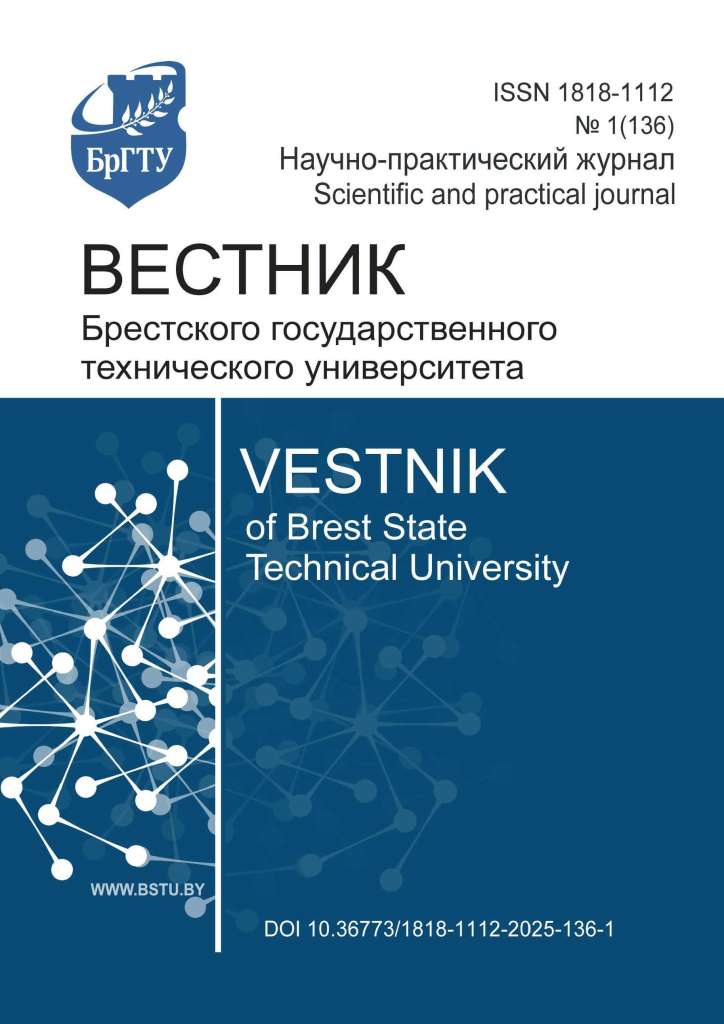SIMULATION OF CONCRETE MASS THERMAL HOLDING MODE
DOI:
https://doi.org/10.36773/1818-1112-2025-136-1-29-37Keywords:
concrete, concrete composition, thermal exposure, influencing factors, method improvement, hardening mode, mathematical model, softwareAbstract
High quality of concrete products, structures and buildings is the result of a set of measures: correct choice of materials, rational selection of concrete mix composition, proper organization and step-by-step control of concrete works, use of reasonable technological methods of preparation, transportation, laying of concrete mix and concrete hardening modes. Rational selection of composition and optimal conditions of concrete hardening determine not only its high strength, water resistance, frost resistance, corrosion resistance, but also, what is especially important, the cost of the structure. The need to reduce costs and save energy resources when erecting concrete and reinforced concrete structures has led to the need to solve the problem of calculating the parameters of concrete hardening in a variable temperature regime, which remains quite relevant, despite the significant scientific and practical experience accumulated to date. To solve this problem, we are developing new analytical dependencies linking the temperature and time of hardening with the formation of structural and mechanical characteristics of concrete.
Computer-aided modeling of concrete hardening processes is a developing promising area in concrete technology and construction work. This area is of particular importance in calculating concrete hardening modes for both massive structures of various purposes and for concreting structures of complex architectural forms that are difficult to calculate using traditional analytical methods of calculating concrete hardening mode. Using the software presented in the article will allow designing the concrete composition and selecting its hardening mode, which will ensure the achievement of the required structural and physical-mechanical characteristics. This will relieve the process engineer from the need to carry out a large amount of work for experimental verification of the selected concrete compositions and its hardening modes. The authors are conducting further testing of the mathematical model, which mutually links the technological (kinetics of changes in concrete characteristics) and heat engineering (current ambient temperature and methods of heat supply) aspects of the concrete hardening process.
References
Бабицкий, В. В. Программное обеспечение расчетов параметров предварительного электроразогрева бетонной смеси / В. В. Бабицкий, Ж. Л. Зеленковская // Современные проблемы внедрения европейских стандартов в области строительства : сборник трудов Междунар. науч.-техн. конф. – Минск, 2015. – С. 43–48.
Батяновский, Э. И. Технология зимнего монолитного бетонирования / Э. И. Батяновский, Н. М. Голубев, В. В. Бабицкий, М. Ф. Марковский. – Минск : БНТУ, 2005. – 237 с.
Михайлов, В. В. Новая технология тепловлажностной обработки конструкций / В. В. Михайлов, А. К. Караковский, В. С. Волков // Бетон и железобетон. – М. : Стройиздат. – 1988. – № 12. – С. 4–10.
Синякин, А. Г. Совершенствование режимов твердения бетонов с учетом неизотермического тепловыделения цемента : автореферат канд. техн. н. / А. Г. Синякин. – Харьков, 1995. – 18 с.
Мчедлов-Петросян, О. П. Тепловыделение при твердении вяжущих веществ и бетонов / О. П. Мчедлов-Петросян, А. В. Ушеров-Маршак, А. М. Урженко. – М. : Стройиздат, 1984. – 224 с.
Шифрин, С. А. Кинетика тепловыделения цемента и выбор эффективных режимов теплового воздействия на монолитный бетон : автореферат канд. техн. н. / С. А. Шифрин. – М., 1979. – 20 с.
Лысов, В. П. Формирование ресурсосберегающих технологических процессов возведения конструкций из монолитного бетона : автореферат доктора техн. н. / В. П. Лысов. – М., 1984. – 38 с.
Бобко, Ф. А. Обоснование режимов возведения бетонных и железобетонных конструкций на основе оптимизации энергетического потенциала технологических процессов. Результаты исследований, основы моделирования и прогнозирования : автореферат доктора техн. н. / Ф. А. Бобко. – Мн., 1998. – 39 с.
Дворкин, Л. И. Проектирование состава бетона при термосном выдерживании конструкции / Л. И. Дворкин, Ю. В. Гарницкий // Бетон и железобетон. – 2000. – № 6. – С. 9–15.
Лукьянов, В. С. Расчеты температурного режима бетонных и каменных конструкций при зимнем производстве работ / В. С. Лукьянов. – М. : НКПС Трансжелдориздат, 1934. – 91 с.
Запорожец, И. Д. Тепловыделение бетона / И. Д. Запорожец, С. Д. Окороков, А. А. Парийский. – Ленинград : Стройиздат, 1966. – 316 с.
Бабицкий, В. В. Температура, как фактор интенсивности роста прочности бетона / В. В. Бабицкий, Ж. Л. Зеленковская // Проблемы повышения качества и ресурсосбережения в дорожной отрасли : сборник трудов Международной научно-технической конференции. – Минск, 2013. – С. 82–86.
Попович, С. Кинетика прочности портландцементного камня / С. Попович // Бетон и железобетон. –1972. – № 3. – С. 6–14.
Бабицкий, В. В. Прогнозирование кинетики твердения бетона при термосном выдерживании конструкций / В. В. Бабицкий // Строительные материалы, оборудование, технологии XXI века: информационный научно-технический журнал. – 2005. – № 4. – С. 66–67.
Бабицкий, В. В. Прогнозирование характеристик твердеющего тяжелого бетона / В. В. Бабицкий, С. Д. Семенюк, М. С. Бибик // Ресурсоекономниi матерiали, конструкцii, будiвлi та споруди : збiрник наукових праць. – Рiвне, 2009. – Випуск 18. – С. 3–12.
Ушеров-Маршак, А. В. «Термобетон-М» – информационная технология монолитного бетона / А. В. Ушеров-Маршак, Ю. Б. Гиль, А. Г. Синякин // Бетон и железобетон. – 2000. – № 4. – С. 2–5.
Марцинкевич, В. Л. Энергосберегающая технология ускоренного твердения бетона / В. Л. Марцинкевич. – Минск : Навука и тэхніка. – 1990. – 248 с.
Интенсификация теплообмена при ТВО изделий / В. П. Абрамов, В. В. Шмалько, В. П. Виноградов [и др.] // Бетон и железобетон. – 1988. – № 4. – С. 10–14.
Non-linear material modelling strategy for conventional and high-performance concrete assisted by testing / N. Pressmair, F. Brosch, M. Hammerl, B. Kromoser // Cement and Concrete Research. – 2022. – Vol. 161. – Paper 106933. – DOI: 10.1016/j.cemconres.2022.106933.
Сафаров, А. Р. Реализация численной модели бетона CSCM применительно к отечественным классам бетонов / А. Р. Сафаров, В. Б. Дорожинский, В. И. Андреев // Вестник МГСУ. – 2023. – Т. 18, № 4. – С. 545–555. – DOI: 10.22227/1997-0935.2023.4.545-555.
Downloads
Published
How to Cite
Issue
Section
License

This work is licensed under a Creative Commons Attribution-NonCommercial 4.0 International License.
The work is provided under the terms of Creative Commons public license Attribution-NonCommercial 4.0 International (CC BY-NC 4.0). This license allows an unlimited number of persons to reproduce and share the Licensed Material in all media and formats. Any use of the Licensed Material shall contain an identification of its Creator(s) and must be for non-commercial purposes only. Users may not prevent other individuals from taking any actions allowed by the license.










